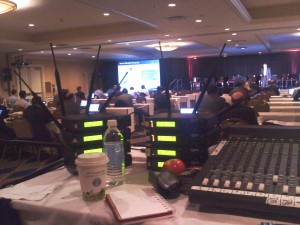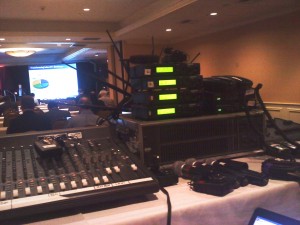Working With Wireless Mics
HI, today I’m going to write a little bit about wireless microphones. Other than projectors, wireless mics can be one of the most temperamental items of gear you will use on an A/V gig. Heck, just last Sunday at Glide, we had our wireless hand-held completely drop-out due to the antenna simply falling over – and these were UHF true diversity microphones! So let’s jump right into it. I’ll first start with some basic characteristics of wireless systems and then go from there…
Wireless mics can transmit in radio waves using UHF or VHF frequencies, FM, AM, or various digital modulation schemes. Some low cost models use infrared light and require a direct line of sight between the microphone and the receiver, while costlier radio frequency models do not. Some models operate on a single fixed frequency, but the more advanced models operate on a user selectable frequency to avoid interference, and allow the use of several microphones at the same time much like in the pictures to the right of this text.
The professional models transmit in VHF (Very High Frequency) or UHF (Ultra High) radio frequency and have “true diversity” reception (two separate receiver modules each with its own antenna), which eliminates dead spots (caused by phase cancellation) and the effects caused by the reflection of the radio waves on walls and surfaces in general. In the United States, the FCC has banned devices to operate in the 698–806 MHz portion of the frequency spectrum due to their auction of the 700 MHz band to broadcasters, cable networks, television and film producers.
Digital Hybrid systems are now available and use an analog FM transmission scheme in combination with digital signal processing (DSP) to enhance the system’s audio. Pure digital systems take various forms as some systems use “frequency-hopping spread spectrum” technology, similar to that used for cordless phones (think: relay towers you see everywhere for your wireless phone). As this can require more bandwidth than a wideband FM signal, these microphones typically operate in the 900 MHz, 2.4 GHz or 6 GHz unlicensed (also known as de-regulated or licence exempt) bands.
Media One just purchased the Shure PGXD 24/Beta 58A digital wireless and we like the results so far.
And despite their “true diversity”, when working with wireless microphones, I always try and make sure the receivers have a clear line of sight to the transmitting microphone. I know the products claim they work behind closed spaces, doors or can pass through cement or wooden walls, but it has been my experience that when the receiver does not have a clear line of site to the transmitting hand-held or lavaliere microphone, you introduce “dead spots” in the transmission and drop-outs occur. This is purely from my personal experience as I am not providing technical data to support this claim. Also make sure your antennas are fanned-out much like in these photos. It just helps the frequency finds its home without having to go through more clutter.
I hope this information was helpful. Happy gigging!
🙂
PS Media One acknowledges Wikipedia for some of the technical information provided in this blog.




